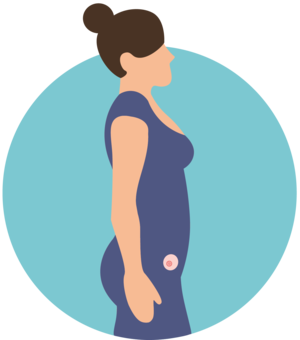Pregnancy at weeks 1 to 4
4-minute read
Your baby
Your pregnancy is calculated according to the first day of your last period. In the first week of your menstrual cycle, and in the second week your ovaries release an egg (called an ovum). This is fertilised by your partner’s sperm sometime in the third week.
About 30 hours after conception, the fertilised egg divides into two. At this stage it is called a zygote. The cells keep dividing and multiplying in numbers and the zygote gradually moves down the fallopian tube towards the womb (uterus).
By the end of the fourth week, the egg implants itself into your uterus. It is now called a blastocyst. It is about 0.2mm wide and contains about 200 cells.
The blastocyst is made up of different layers of cells. The outer layer, called the ectoderm, will become the baby’s nervous system and brain. The middle layer, or mesoderm, will become the heart, blood vessels, muscles, and bones, and the inner layer, or endoderm will become the breathing and digestive systems. The outside of the blastocyst has small tentacles called chorionic villi, which will develop into the placenta.
Your baby at 1 to 4 weeks
| Length: | 0.2mm |

Your body
As soon as you conceive, the hormone levels in your body start to change. You produce more of the hormone progesterone, which prevents you from having a period, and there is an increase your levels of human chorionic gonadotropin (hCG). This is the pregnancy hormone that is detected when you do a pregnancy test.
You probably won’t notice any signs that you’re pregnant just yet. The first sign for many women is that they miss their period at the end of week 4.
Things to remember
Your baby will have the best possible start in life if you make sure you are healthy when you conceive.
If you are trying for a baby, it’s a good idea to take 400 micrograms of folate every day to prevent neural tube defects such as spina bifida. If the baby is planned, you might consider seeing your doctor to talk about genetic screening or to be tested for any sexually transmitted infections before you fall pregnant.
You should try to eat a healthy diet and make sure you’re not overweight when you’re trying to fall pregnant. Not drinking alcohol and giving up smoking are best for your baby.
Read more here about preconception health.
Read next

Your pregnancy at 5 weeks
Learn about your pregnancy journey and what is happening to you and your baby.

Speak to a maternal child health nurse
Call Pregnancy, Birth and Baby to speak to a maternal child health nurse on 1800 882 436 or video call. Available 7am to midnight (AET), 7 days a week.
Learn more here about the development and quality assurance of healthdirect content.
Last reviewed: August 2020




